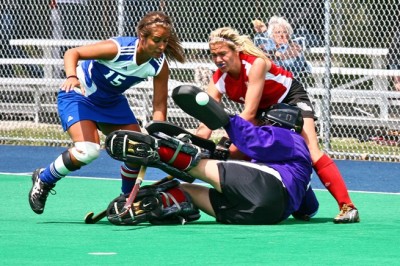
Current Challenges
- Current game formats, leagues, and tournaments in Canada are often unsuitable for the players and regions they serve.
- Competition structure is not integrated or rationalized at all levels across Canada.
- No periodization guidelines exist for player training, competition, and recovery.
- Varying playing surfaces, climates and extreme weather hamper training and playing outdoor field hockey
- Length of season is inappropriate (e.g. BC is too long, rest of Canada is too short).
- Adult game structure is imposed on children (e.g. 11v11 on a full field).
- Many programs do not distinguish between recreational and elite players.
- Seasons overlap between club, school, and select teams, resulting in over-competition and inconsistent coaching.
- Seasons overlap with other sports, resulting in over-competition.
- National team program exposes a relative few players to international competition.
- Canadian National Team players encounter timing conflicts when playing university field hockey or club hockey (e.g. NCAA, CIS, domestic club).
- Some players are committed to international clubs at the expense of National Team Program or Domestic competition.
LTHD Vision
- Existing competition model is reviewed and the recommendations implemented.
- Competition structure is defined at each stage, including training-competition ratios, periodization, season length, standings, playoffs, cup championships, and player statistics.
- Guidelines are established for the incidence of competition (e.g. tournaments).
- In the lower stages competition is used as a tool for player development and not its purpose.
- Appropriate levels of competition are defined for each stage.
- International normative data is collected.
- Appropriate age groupings are defined for group training.
- Access to competition is improved, minimizing travel and costs.
- Overlap between field hockey programs is reduced (i.e. schools, clubs, regional, Provincial and National teams).
- Competition guidelines address unique geographical demands of different regions.
- Ongoing campaign promotes positive and supportive field hockey culture among parents and players.
- Year-round facilities (Indoor / outdoor) are available for U14 programs and above.
- Quality umpires work at all levels, communicating standards of conduct to players, coaches, and parents.
- More players participating in regional, provincial, and international competitions at the Training to Train and Training to Compete stages.
- Larger player pool exists for National teams.
- National scheduling plan is established to accommodate competitions.
- Consistent competition structure is established for different age groups across Canada.
Implementation
- Revise the competition structure to match the needs of players at each developmental stage.
- Technical experts design and lead Canadian competition system.
- Eliminate adult game formats in children’s programs.
- Establish recommended game formats for all development stages
- Refine and expand leagues across Canada
- Create a National Club Championship – schedule when University teams can play
- Establish annual Regional Championships
- Establish appropriate national championship structures both practically appropriate and in line with LTHD.
- Implement appropriate recognition policy (ie. Tournament XI, trophies etc.)
- National Talent identification takes place at appropriate events
- Create opportunity for both indoor and outdoor competitions where demand dictates.
- Define plans for periodized training, competition, and recovery at all levels.
- Differentiate between recreation players and performance players in programming.
- Establish programs based on biological age (physical maturation) rather than chronological age.
- Try and reduce overlapping seasons between schools, clubs, and district select teams.
- Work with other sports to reduce overlapping seasons.
- Clearly define the role of the different competition structures (University, etc…).
- Develop a guide for player development during games for every stage of development.
- Create an environment to ensure sustained success for National teams in international competition.
- Host international competitions annually.

